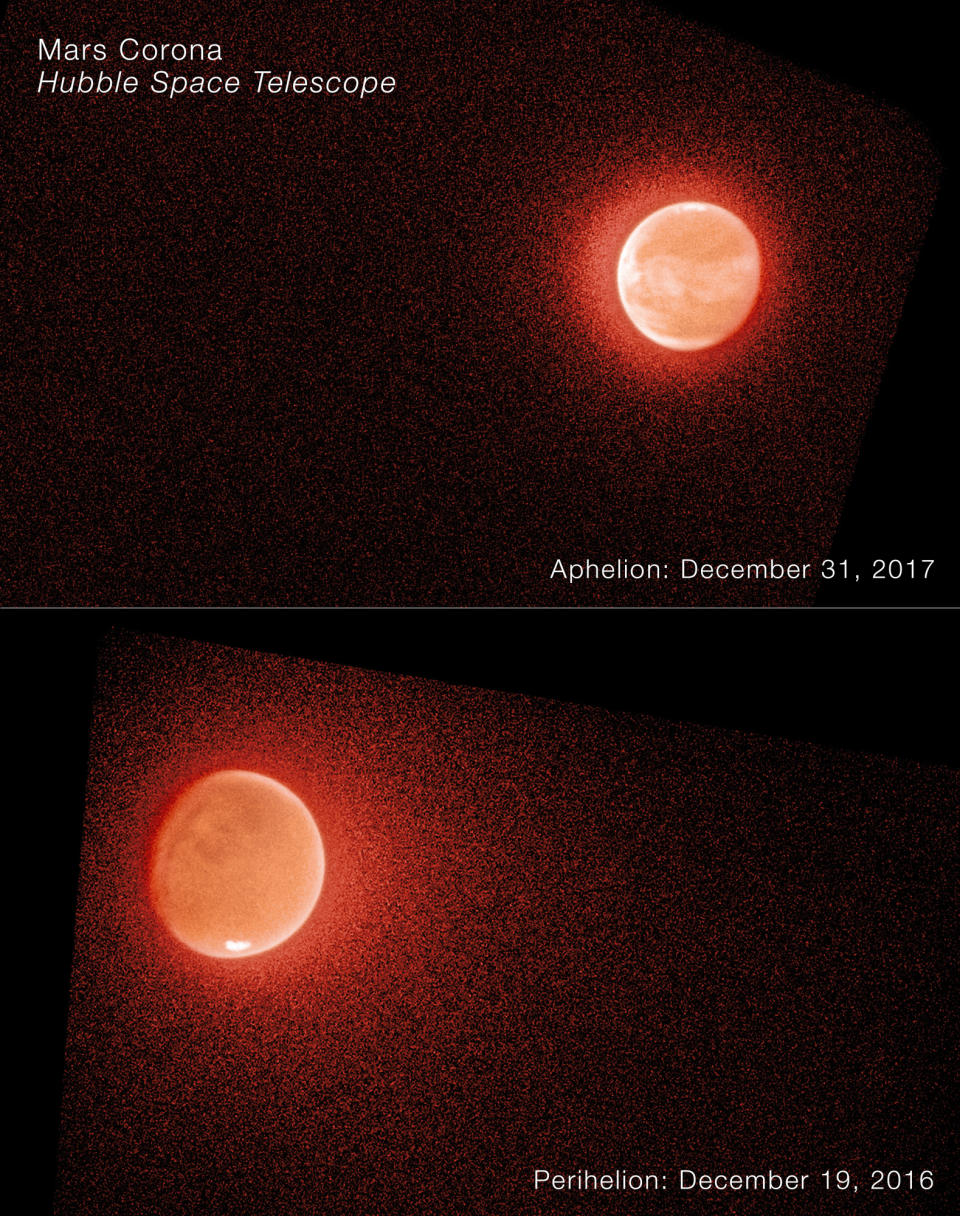When you buy through links on our articles, Future and its syndication partners may earn a commission.

Seasonal changes can have a dramatic effect on how quickly Mars loses its water to space, a joint study between the Hubble Space Telescope and NASA’s Mars Atmosphere and Volatile Evolution (MAVEN) mission has shown.
Over three billion years ago, Mars was warm and wet, with large bodies of water on its surface and a thicker atmosphere. Today, however, Mars is desolate, cold and dry. So, what happened to all the water?
“There’s only two places water can go,” John Clarke of the University of Boston said in a statement. “It can freeze into the ground, or the water molecules can break into atoms, and the atoms can escape from the top of the atmosphere into space.”
Plenty of Mars’ water is still on the Red Planet. Vast reservoirs appear to be locked up deep underground at depths between 11.5 and 20 kilometers (7.1 and 12.4 miles). There’s enough water inside Mars for a global equivalent layer (GEL, which essentially refers to how deep a planet-wide ocean it would create) between 1 and 2 kilometers (0.62 and 1.24 miles).
Related: Mars rock samples show signs of water in Jezero Crater — could life have once existed there?
Relatively small amounts of water-ice are also locked up in shallow permafrost and in Mars’ polar ice caps. During the Martian summer, this ice can sublimate, dumping water vapor into the atmosphere. Most of that water vapor circulates from pole to pole, freezing out in the hemisphere in which it is winter, but some finds itself in the upper atmosphere where solar ultraviolet light can photodissociate H2O water molecules, breaking them apart into their component atoms. The oxygen in water ends up either oxidizing materials on the surface (hence, why Mars appears rust-red) or bonding with carbon to form carbon dioxide. Meanwhile, the hydrogen atoms (or their heavier isotopic counterpart, deuterium) can escape into space (if they are energetic enough to reach escape velocity) and get carried away with the solar wind.
MAVEN, which arrived at Mars in 2014, is tasked with measuring this hydrogen escape.


Because deuterium, a heavy form of hydrogen, doesn’t escape Mars’ atmosphere so easily, it means that the ratio of deuterium to hydrogen (D/H) in Mars’ atmosphere is key, with the abundance of deuterium relative to hydrogen growing over time as it loses hydrogen faster. As Earth and Mars are presumed to have acquired their water from the same sources, the primordial D/H ratio of water on Mars 3 billion to 4 billion years ago should have been the same as it is on Earth today. The D/H ratio on Mars today is somewhere between 8 and 10 times larger than on Earth. There are certain ambiguities in the measurements, but by comparing that primordial Mars water ratio to today’s ratio while factoring in the rate of hydrogen and deuterium loss to space, it is possible to extrapolate backwards and calculate how much water Mars likely lost over its history.
Based on MAVEN’s previous observations, Mars has lost enough water to space to form a GEL of between tens and hundreds of meters deep. Combined with the huge amount of water recently found buried inside Mars, this implies the Red Planet was water-rich in its distant past.
However, MAVEN, with the Hubble Space Telescope’s help, has now found some unanticipated complexity to the story of Mars’ water loss. Together, the instruments have shown that the rate of hydrogen loss is seasonal, with large increases in the escape rate at perihelion, which is Mars’ closest point in its orbit around the sun. This coincides with a strong upwelling of water vapor into the middle atmosphere, caused by seasonal heating. When at perihelion, Mars’ southern hemisphere is tilted towards the sun and the Red Planet is engulfed in its annual dust storm season; the airborne dust can contribute to atmospheric heating and water vapor content.
At perihelion, MAVEN measured densities of deuterium and hydrogen in the upper atmosphere that are respectively about 5 and 20 times higher than at aphelion, which is Mars’ farthest point from the sun in its elliptical (elongated, rather than circular) orbit. At aphelion, the deuterium loss is so feeble that MAVEN is not even sensitive enough to detect it. This is where the Hubble Space Telescope has to come in, filling in the blanks. The observations also showed that the escape rates are 10 to 100 times higher for deuterium and hydrogen respectively at perihelion than at aphelion. Indeed, both deuterium and hydrogen are escaping so rapidly at perihelion that the only thing limiting them is the amount of water vapor available in the atmosphere.
Related Stories:
— Ocean’s worth of water may be buried within Mars — but can we get to it?
— ‘We thought it was impossible:’ Water frost on Mars discovered near Red Planet’s equator
— Is there really a huge subsurface lake near Mars’ south pole?
“In recent years scientists have found that Mars has an annual cycle that is much more dynamic than people expected 10 or 15 years ago,” said Clarke. “The whole atmosphere is very turbulent, heating up and cooling down on short timescales, even down to hours. The atmosphere expands and contracts as the brightness of the sun at Mars varies by 40% over the course of a Martian year.”
This does set up a conundrum when explaining the deuterium loss, which appears greater than what would be expected purely from ordinary thermal escape, where a deuterium atom is warm enough to have the energy needed to skip into space. To increase the rate of deuterium loss so that it matches the observed D/H ratio on Mars, an extra injection of energy into the atmosphere is required from somewhere. This could come from protons on the solar wind entering the atmosphere and colliding with deuterium atoms, or chemical reactions from solar ultraviolet light that can give the deuterium an extra kick.
The findings were published on July 26 in the journal Science Advances.

Dr. Sarah Adams is a scientist and science communicator who makes complex topics accessible to all. Her articles explore breakthroughs in various scientific disciplines, from space exploration to cutting-edge research.







